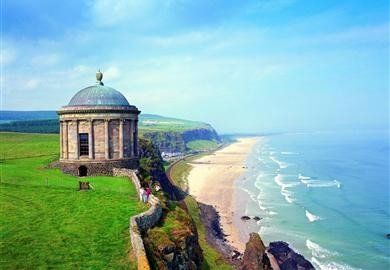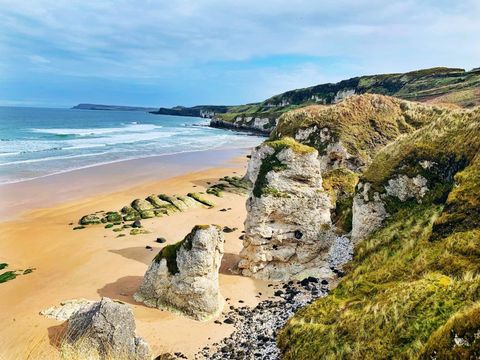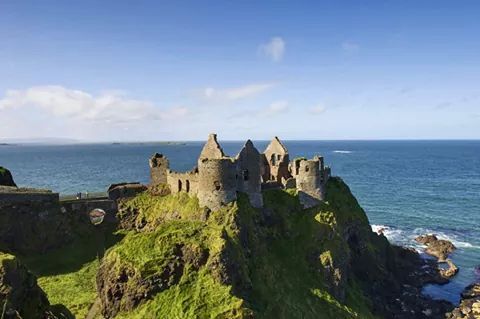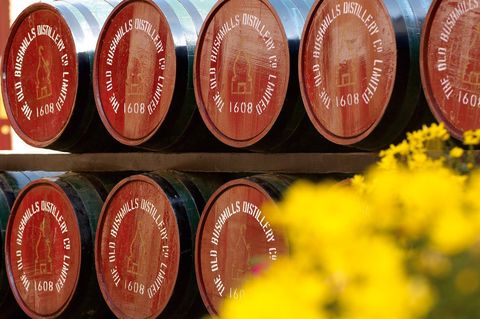Welcome to ReubensLoft.Com
Ultra Fast & Free Wifi
Attractions
Attractions
Roe Valley Park
Roe Valley Park
The river plunges through spectacular gorges and its banks are clothed in mature woodland. This picturesque park is also the main habitat to a number of animals which include foxes, badgers and otters. There is a disabled angler's jetty by the river and a specially designed trail emphasising the wildlife of the park. This includes an audio guide for blind and partially sighted visitors. Paths provide access throughout much of Roe Valley and seating is available at various points, including special benches for the less able-bodied. Also worth a visit is the newly refurbished ‘Ritters Tea Room’ which opens daily and is located on the left bank upriver of the Dogleap Centre from which a mobility scooter may also be borrowed.
Visitors can learn about the industrial and natural heritage of the area in the museum and countryside centre. The remains of buildings used in the linen industry and a restored water wheel can also be seen and much of the original equipment is preserved including ruined water mills used in linen production.
Main car park at Visitor Centre /Café Building (access via Dogleap Road)
Open all year round to pedestrians.
Car parks available every day 24 hours a day, 7 days a week (except for Christmas Day, Boxing Day and New Years Day).
Visitor Centre: 1st April to 30th September open every day 10.00 – 16.00, 1st October to 31st March open Sundays 13.00 – 16.00
Toilets: 1st April to 30th May 9.00 – 19.00, 1st June to 16th September 9.00 – 21.00, 17th September to 31st March 9.00 – 16.30
Café: opening hours contact (028) 7772 2020
Benone Strand & Visitors Centre
Benone Beach, multiple recipient of the European Blue Flag and Seaside Award, is a must-see when visiting the area. With seven miles of golden sand and a magnificent back drop of mountain and cliff scenery and stunning views across to Donegal, this is an attractive sightseeing environment along with the usual seaside activities including picnic spots, watersports, and fishing.
Mussenden Temple
Mussenden Temple is located in the beautiful surroundings of Downhill Demesne near Castlerock in County Londonderry. It perches dramatically on a 120 ft cliff top, high above the Atlantic Ocean on the north-western coast of Northern Ireland, offering spectacular views westwards over Downhill Strand towards Magilligan Point and County Donegal and to the east Castlerock beach towards Portstewart, Portrush and Fair Head
Whiterock Coastal Park
Situated just off the Causeway Coastal Route, Whiterocks Coastal Park enjoys a stunning natural location, with limestone cliffs stretching from Curran Strand to Dunluce Castle.
On a year round basis, the beach is a magnet for water sports enthusiasts, especially surfers, but body boarders and surf kayakers are also regular visitors. A seasonal on site surf outlet provides equipment for hire.
The beach is also very popular with walkers to and from Portrush along the continuous stretch of sand from East Strand to Whiterocks. Enjoy the new section cliff path, part of the Ulster Way / Causeway Coast Way, which offers stunning views both east and west.
Dunluce Castle
The iconic ruin of Dunluce Castle bears witness to a long and tumultuous history. First built on the dramatic coastal cliffs of north County Antrim by the MacQuillan family around 1500, the earliest written record of the castle was in 1513.
It was seized by the ambitious MacDonnell clan in the 1550's, who set about stamping their mark on the castle under the leadership of the famous warrior chieftain Sorely Boy MacDonnell during an era of violence, intrigue and rebellion.
In the 17th century Dunluce was the seat of the earls of Antrim and saw the establishment of a small town in 1608. Visitors can explore the findings of archaeological digs within the cobbled streets and stone merchants’ houses of the long-abandoned Dunluce Town
Bushmills Distilery
Giants Causeway
Carrick a Rede
A superb restoration project has helped preserve the heritage of a 400-year-old Salmon Fishery at Carrick-a-Rede. The project, a partnership between the National Trust and DARD/North East Region (NER) Local Action Group, ensures that the history and traditions of a once thriving industry will live on for future generations.
A new guided visitor experience helps provide a sense of place and connection with the famous rope bridge on the North Antrim coast.
Rathlin Island
The ferry to Rathlin Island travels just six miles across the Sea of Moyle. This island is six miles long, one mile wide, "L" shaped and home to a slowly increasing population of around 140 people.
A short walk from the harbour is the Boathouse Visitor Centre, where visitors can discover some of the exciting history, learn about present day island life and see some artefacts from shipwrecks around the island. Enjoy many of the walks the Island has to offer including along the shore to Mill Bay where you may see some of the resident seals basking or at play. Cycle hire is another way to enjoy the island or take a bus trip.
Dark Hedges
Dark Hedges
It was intended as a compelling landscape feature to impress visitors as they approached the entrance to their Georgian mansion, Gracehill House. Two centuries later, the trees remain a magnificent sight and have become one of the most photographed natural phenomena in Northern Ireland. In fact, the iconic trees have been used as a filming location in HBO's epic series Game of Thrones®, representing the Kingsroad.
Featured Scene: Season 2, Episode 1: The North Remembers - On the King's Road, Arya Stark has escaped from King’s Landing, disguised as a boy. She is with Yoren, Gendry, Hot Pie and others who are to join the Night’s Watch, in a cart, travelling north on the Kingsroad. Find out about other Game of Thrones® Filming Locations in Northern Ireland at www.discovernorthernireland.com/gameofthrones
Joey & Robert Dunlop Memorial Gardens
His incredible sporting career included five Formula One World Championships; 13 wins at the North West 200; 24 wins at the Ulster Grand Prix and a world record of 26 wins at the Isle of Man Tourist Trophy. His sporting achievements were recognised by Her Majesty the Queen when he was awarded an MBE in 1986. Ten years later he was presented with an OBE for his remarkable humanitarian work with children in Eastern Europe.
Tragically Joey lost his life whilst racing in Estonia on 2nd July 2000. It is estimated that 60,000 people from across the world came to Ballymoney to attend his funeral. In May 2001 Ballymoney Borough Council officially opened the Joey Dunlop Memorial Garden.
Joey's brother, Robert Dunlop was 19 years old when he made his debut at the Temple 100. He was soon winning races, at the North West 200, Ulster Grand Prix and Isle of Man TT and riding everything from 125cc to superbike. By 1991, he had won Ulster, Irish and British Championships including five wins at the Isle of Man, 15 at the North West 200 and nine at the Ulster Grand Prix. In addition, he won Grands Prix in Indonesia and Macau.
Robert Dunlop was tragically killed on 15 May 2008, during a qualifying session for the 250cc race at the North West 200. His son Michael insisted on riding in the same race only two days later. In one of the most memorable and emotional moments in Irish sporting history, Michael won the race "I had to do it for him - I hope my dad's proud of me."
Glenarrif Forest Park
Glenariff Forest Park is open to the public and caters for many outdoor activities including walking, horse riding and touring. It has picnic and barbeque areas as well as a tea house.
The rocky gorges of the river support a wide range of mosses, liverworts and ferns. Due to the richness and diversity of these plants, part of the Glenariff Glen has been designated as a National Nature Reserve. The timber walkway (boardwalk) that winds through the glen and alongside the river gorge was first built about 100 years ago and has been carefully reconstructed to provide a spectacular walk.
Arthur Cottage
Glenarm Castle
Until the middle of the eighteenth century the Antrim Estate extended all the way up the coast of County Antrim to Dunluce Castle, Ballycastle and beyond. Now, however, it is limited almost entirely to the land that sits within the walls of the Castle Demesne.
Today the Demesne, which was once a deer park, is a working estate consisting of forest, farmland and the Glenarm River. The Glenarm River is approximately 5 miles long, with the Glenarm Angling Club fishing two miles and a private syndicate fishing the remaining three miles.
Slemish Mountain
Slemish Mountain, the legendary first known Irish home of Saint Patrick, is located in County Antrim. The mountain rises about 1500 feet (437 metres) above the surrounding plain, and it is actually the central core of an extinct volcano.
According to legend, following his capture and being brought as a slave to Ireland, Patrick worked as a shepherd at Slemish Mountain for about six years, from ages 16 through 22, for a man named Milchu (or Miluic). It was during this time that Patrick turned to frequent prayer as his only consolation in his loneliness. In a vision he was encouraged to escape and return home.
Carnfunnock Park
For a fun family or group day out in Larne, County Antrim bring the kids to Carnfunnock Country Park and discover our unique attractions, activities and events. Located less than 25 miles from Belfast, on the breathtaking Antrim Coast Road, this 191 hectare park also contains a 5 star touring caravan park and campsite, perfect for visitors from the UK, Ireland and overseas to explore N. Ireland.
The Gobbins
Carrickfergus Castle
Carrickfergus Castle is a Norman castle in Northern Ireland, situated in the town of Carrickfergus in County Antrim, on the northern shore of Belfast Lough.
Besieged in turn by the Scots, Irish, English and French, the castle played an important military role until 1928 and remains one of the best preserved medieval structures in Ireland.
For more than 800 years, Carrickfergus Castle has been an imposing monument on the Northern Ireland landscape whether approached by land, sea or air. The castle now houses historical displays as well as cannons from the 17th to the 19th centuries.
Balintoy Harbour
The small fishing harbour can be found at the end of a small narrow steep road down Knocksaughey Hill, which passes by the entrance to Larrybane and Carrick-a-Rede Rope Bridge. The village itself, which is just one kilometre from the harbour, has a charming array of small shops, two churches, including the quaint white Ballintoy Parish Church on the hill above the harbour, as well as tourist accommodation, restaurants, commercial and social facilities.
For those looking to capture a true sense of Irish rural life, it is an ideal stop over whilst touring the coastal route.
Mountsandel Fort
Mountsandel Wood is the earliest known settlement of man in Ireland dating to between 7600 and 7900BC.
Flint tools were found here, indicating that Stone Age hunters camped here to fish salmon in the natural weir. The earthen fort is thought to date back to Norman times.
The forest walk leads from the fort down to the banks of the Bann and passes close to the weir at The Cutts.
There are good views over Somerset Wood and of the River Bann.
Swans, kingfishers and herons nest along the riverside
32 Ballywatt Road, Coleraine, BT52 2LT, United Kingdom
| 07921 867 787 Int: 00447921 867 787




















